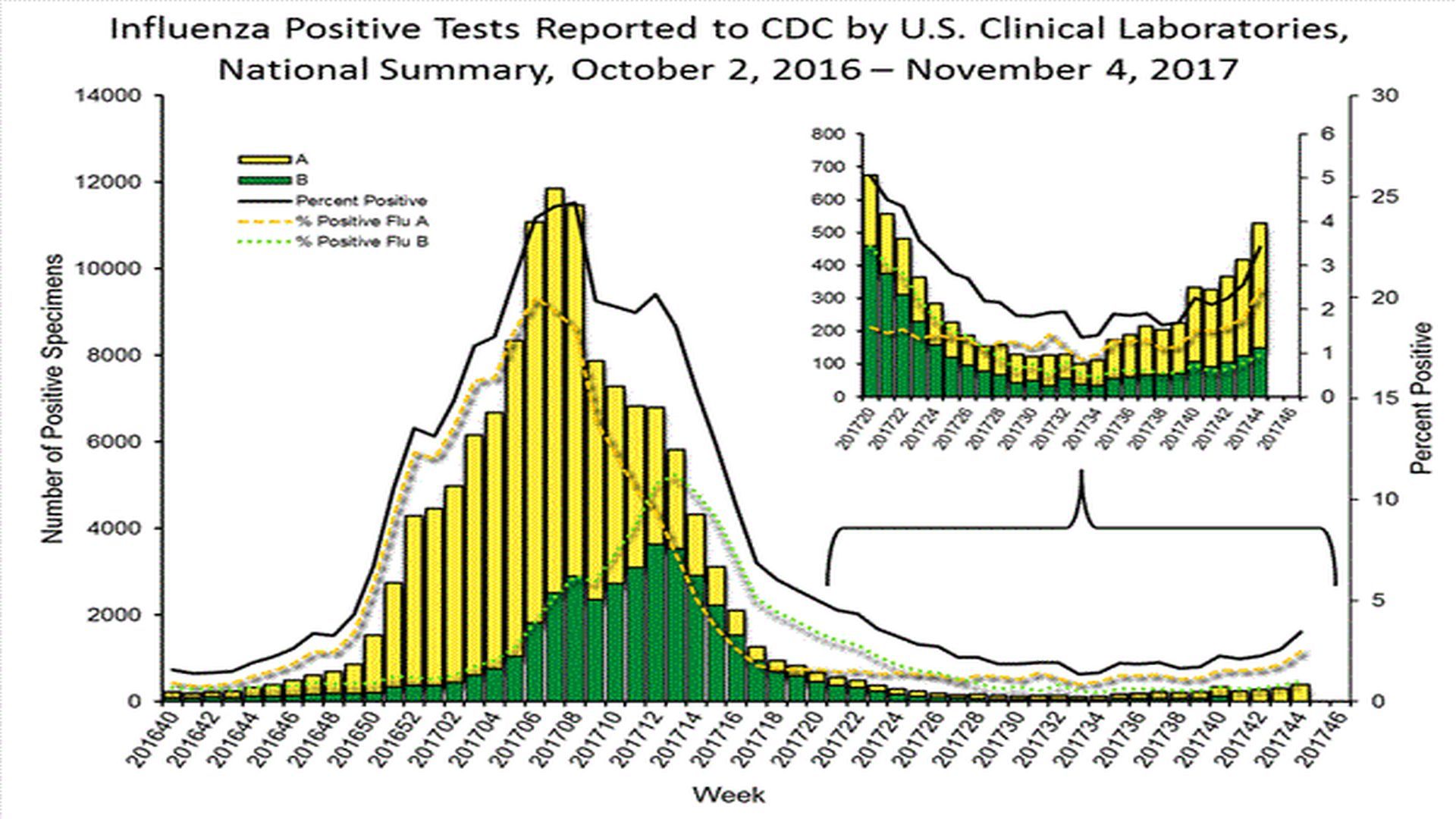CDC Flu Update: Overall Activity is Low but Increasing


According to the latest FluView report from the Centers for Disease Control and Prevention (CDC), seasonal influenza activity remained low overall in the United States, but is increasing. However, six states and Guam reported regional flu activity and 13 states reported local influenza activity. Flu vaccine is the best available way to protect against influenza. The CDC recommends that everyone 6 months and older get an injectable flu vaccine as soon as possible.
Influenza-like Illness Surveillance: For the week ending November 4, the proportion of people seeing their health care provider for influenza-like illness (ILI) was 1.8% and is below the national baseline of 2.2%. All 10 regions reported a proportion of outpatient visits for ILI below their region-specific baseline levels.
Additional ILINet data, including national, regional, and select state-level data for the current and previous seasons, can be found at http://gis.cdc.gov/grasp/fluview/fluportaldashboard.html.
Influenza-like Illness State Activity Indicator Map: Two states experienced moderate ILI activity (Louisiana and South Carolina). Six states (Alabama, Arizona, Georgia, Mississippi, South Dakota, and Wyoming) experienced low ILI activity. New York City, the District of Columbia and 42 states experienced minimal ILI activity (Alaska, Arkansas, California, Colorado, Connecticut, Delaware, Florida, Hawaii, Idaho, Illinois, Indiana, Iowa, Kansas, Kentucky, Maine, Maryland, Massachusetts, Michigan, Minnesota, Missouri, Montana, Nebraska, Nevada, New Hampshire, New Jersey, New Mexico, New York, North Carolina, North Dakota, Ohio, Oklahoma, Oregon, Pennsylvania, Rhode Island, Tennessee, Texas, Utah, Vermont, Virginia, Washington, West Virginia, and Wisconsin). Data were insufficient to calculate an ILI activity level from Puerto Rico. Additional data, including data for previous seasons, can be found at https://gis.cdc.gov/grasp/fluview/main.html.
Geographic Spread of Influenza Viruses: Regional influenza activity was reported by Guam and six states (Georgia, Louisiana, Massachusetts, Oklahoma, South Carolina, and Texas). Local influenza activity was reported by Puerto Rico and 13 states (Alabama, Alaska, Arizona, Arkansas, California, Colorado, Connecticut, Hawaii, Maine, Mississippi, New Mexico, Ohio, and Oregon). Sporadic activity was reported by the District of Columbia and 31 states (Delaware, Florida, Idaho, Illinois, Indiana, Iowa, Kansas, Kentucky, Maryland, Michigan, Minnesota, Missouri, Montana, Nebraska, Nevada, New Hampshire, New Jersey, New York, North Carolina, North Dakota, Pennsylvania, Rhode Island, South Dakota, Tennessee, Utah, Vermont, Virginia, Washington, West Virginia, Wisconsin, and Wyoming). Puerto Rico and the U.S. Virgin Islands did not report. Geographic spread data show how many areas within a state or territory are seeing flu activity.
Additional data are available at: https://gis.cdc.gov/grasp/fluview/FluView8.html.
Flu-Associated Hospitalizations: Reporting of influenza-associated hospitalization data from the Influenza Hospitalization Surveillance Network (FluSurv-NET) for the 2017-2018 influenza season will begin later this season.
Additional data, including hospitalization rates during other influenza seasons, can be found at http://gis.cdc.gov/GRASP/Fluview/FluHospRates.html and http://gis.cdc.gov/grasp/fluview/FluHospChars.html.
Mortality Surveillance:
The proportion of deaths attributed to pneumonia and influenza (P&I) was 5.8% for the week ending October 21, 2017 (week 42). This percentage is below the epidemic threshold of 6.3% for week 42 in the National Center for Health Statistics (NCHS) Mortality Surveillance System.
Region and state-specific data are available at https://gis.cdc.gov/grasp/fluview/mortality.html.
Pediatric Deaths:
No influenza-associated pediatric deaths were reported to CDC during the week ending November 4.
One influenza-associated pediatric death for the 2017-2018 season has been reported to CDC.
Additional information on pediatric deaths is available on FluView Interactive at: https://gis.cdc.gov/GRASP/Fluview/PedFluDeath.html
Laboratory Data:
Nationally, the percentage of respiratory specimens testing positive for influenza viruses in clinical laboratories during the week ending November 4 was 3.4%.
Regionally, the three week average percent of specimens testing positive for influenza in clinical laboratories ranged from 0.5% to 6.1%.
During the week ending November 4, of the 529 (3.4%) influenza-positive tests reported to CDC by clinical laboratories, 381 (72.0%) were influenza A viruses and 148 (28.0%) were influenza B viruses.
The most frequently identified influenza virus type reported by public health laboratories was influenza A virus.
During the week ending November 4, 108 (80.6%) of the 134 influenza-positive tests reported to CDC by public health laboratories were influenza A viruses and 26 (19.4%) were influenza B viruses. Of the 101 influenza A viruses that were subtyped, 91 (90.1%) were H3N2 viruses and 10 (9.9%) were (H1N1)pdm09 viruses.
The majority of the influenza viruses collected from the United States during May 21 through October 28, 2017 were characterized antigenically and genetically as being similar to the cell-grown reference viruses representing the 2017–18 Northern Hemisphere influenza vaccine viruses. None of the viruses tested from May 21-October 28, 2017 were found to be resistant to oseltamivir, zanamivir, or peramivir.
Three human infections with novel influenza A viruses were reported by 3 states (Colorado [1], Nebraska [1], and Michigan [1]) during the week ending October 28. Two infections were with influenza A(H3N2) variant (H3N2v) viruses and one infection was with an influenza A(H1N2) variant (H1N2v) virus. No ongoing human-to-human transmission was identified.
Source: CDC
Robust infectious disease surveillance, including rapid subtyping of influenza A, is essential for early detection, containment, and public health reporting of novel viral threats.